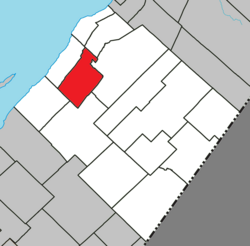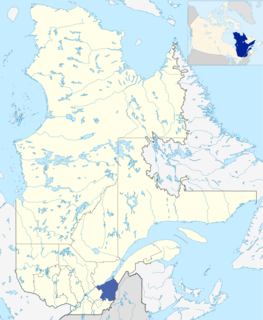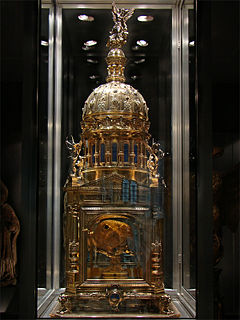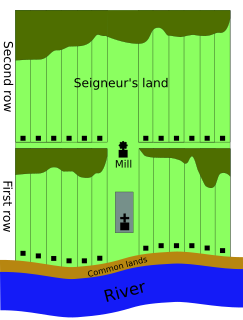Bellechasse was a federal electoral district in Quebec, Canada, that was represented in the House of Commons of Canada from 1867 until the 1997 election, when it became Bellechasse—Etchemins—Montmagny—L'Islet. After redistribution prior to the 2004 election, that riding became Lévis—Bellechasse. Currently, the only riding which includes the name "Bellechasse" is Bellechasse—Les Etchemins—Lévis.
The 2000–2006 municipal reorganization in Quebec resulted in large-scale amalgamation (merging) of smaller municipalities in Quebec into larger cities. It was undertaken by one administration, and modified and partially undone by its successor.

Saint-Damase-de-L'Islet is a municipality in Quebec, Canada, with a population of about 600 people nestled in the Appalachian mountains. It is located about 15 kilometres (9.3 mi) southeast of Saint-Jean-Port-Joli. It is named after the Pope Damasus I and Damase Ouellet (1826–1908), which is known as the pioneer of the town.

Route 204 is a finite two-lane east/west highway on the south shore of the Saint Lawrence River in Quebec. It is one of the longest secondary highways in the province. Its eastern terminus is in Saint-Jean-Port-Joli at the junction of Route 132 and the western terminus is in Lac-Mégantic at the junction of Route 161. Although it is numbered as an east/west highway, the road follows a north/south course from Saint-Jean-Port-Joli to Saint-Pamphile, where it then follows a mostly southwest/northeast course until Saint-Georges, where after crossing the Chaudière River, follows it in a north/south course until the source of the Chaudiere in Megantic Lake, in Lac-Mégantic.
The municipal history of Quebec started in 1796 with the creation of administrations for Montréal and Quebec City, but it really developed immediately prior to the creation of the Province of Canada in 1841 with the formation of municipal districts, followed in March 1845 when the Parliament of the Province of Canada adopted an Act to create local authorities in Lower Canada which took effect in July 1845.

The Matapedia Valley was formed by the Chic-Choc Mountains of eastern Québec. Its name is derived from the river that traverses the valley, as well as the lake that lies in its center. It is situated in the southwest of the Gaspé Peninsula and stretches 375 km (233 mi).
Pierre-Ignace Aubert de Gaspé was a seigneur and political figure in Lower Canada.

Sainte-Thècle is a Canadian municipality located in the province of Quebec in the Mékinac Regional County Municipality, in the Batiscanie watershed, in the administrative region of Mauricie. This municipality of 216 square kilometres is known for its resorts and many small lakes. The forest and mountain scenery offers exceptional views for tourists and vacationers. Sainte-Thècle is also a destination for hunting, fishing, snowmobile/all-terrain vehicles and other outdoor sports. The church, rectory and cemetery are located on the main hill of the village and are also heritage sites of iinterest. The municipality's agricultural and forestry industries have marked its history.
Montmagny-L'Islet is a former provincial electoral district in the Chaudière-Appalaches region of Quebec, Canada that elected members to the National Assembly of Quebec. As of its final election, it included the cities or municipalities of Montmagny, Saint-Jean-Port-Joli, L'Islet, Sainte-Perpétue, Saint-Pamphile and Cap-Saint-Ignace.

Grandes-Piles is a village municipality in the Mauricie region of the province of Quebec in Canada.

Lac-aux-Sables is a parish municipality in the Mékinac Regional County Municipality, in administrative district of the Mauricie region of the province of Quebec in Canada. Its population centres are Lac-aux-Sables and Hervey-Jonction.
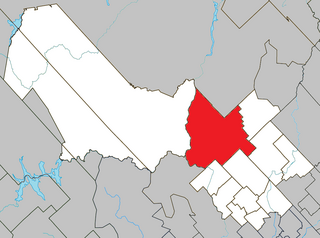
Trois-Rives is a municipality with an area of 675 square kilometres (261 sq mi) located in Mékinac Regional County Municipality, in the Mid-Mauricie, province of Quebec, Canada.

Lac-au-Saumon is a municipality in the Canadian province of Quebec, located in La Matapédia Regional Council Municipality in the Matapédia Valley.
Pamphile-Gaspard Verreault was a farmer, notary and political figure in Quebec. He represented L'Islet in the Legislative Assembly of Quebec from 1867 to 1878 as a Conservative member.

André Rousseau,, was an entrepreneur and politician in Quebec. He was the first to occupy the position of Minister of Industry and Commerce from July 5, 1960 to December 5, 1962 under the first Government of Jean Lesage. In 1950, Rousseau also founded Rousseau Metal inc., a Quebec company that is specialized in the manufacturing of storage systems.
The 2004 Quebec municipal referendums were held by the Quebec Liberal Party government of Jean Charest that came to power in the 2003 Quebec election, in fulfillment of a campaign promise to allow voters to have a say regarding the municipal reorganization program that had been undertaken by the preceding Parti Québécois administration.
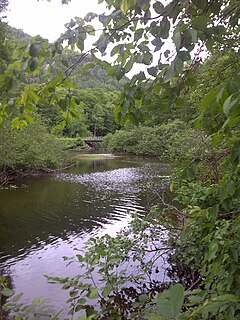
Missionary Lake [formerly named "Grand lac long" ] is located in the municipalities of Trois-Rives and Lac-aux-Sables in the Mekinac Regional County Municipality (RCM), in Batiscanie, in the administrative area of the Mauricie, in the province of Quebec, Canada. It is named in honour of missionary and explorer Paul Le Jeune, one of the founders of the Jesuit mission that was opened in 1634 in nearby Trois-Rivières, Quebec.
